What went wrong for Captain Scott and his team to die on the way back from the South Pole?
Terra Nova Expedition: The pole - p.1 - Preparations | The pole p.2 - Journey | The wider Terra Nova expedition | Time-line and info graphic | Crew of the Terra Nova | What went wrong for Scott to die? | What did Scott's team die of? | Race to the pole Amundsen and Scott | The Northern Party
This page: The Slow Effects of Insufficient Food | Scurvy | Leaking Fuel Cans | Four, then five in the Polar Party | The Role of Amundsen | Misunderstood orders? | Transportation Choices | Weather on the Return Journey
British Antarctic Expedition 1910-13 - Captain Robert Scott and four others hoped to be the first to reach the South Pole, Roald Amundsen beat them by just over a month, while Amundsen and his men came back safely, Scott's party all died on the return from the pole - what led to the deaths of Scott's party?
The last entry in Scott's diary was on the 29th of March 1912, it is assumed but not certain that this was the date on which he died. They had made camp for the last time ten days earlier on the 19th of March. Scott continued to write his diary and letters in this final camp. It seems that he was the last of the three to die. His body and those of Edward Wilson and Henry "Birdie" Bowers were found in the tent nearly eight months later on the 12th of November 1912.
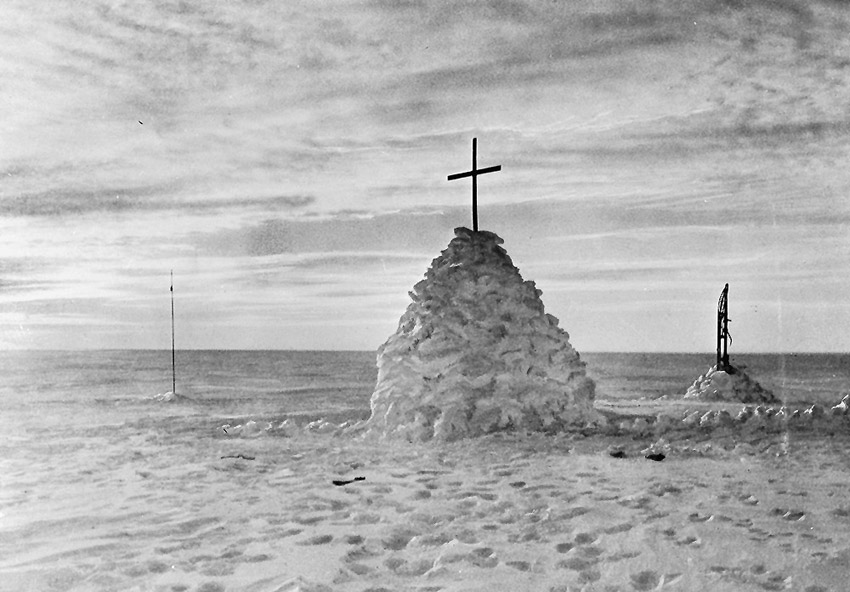 A large snow cairn built
over the final camp and the bodies of Scott, Bowers and Wilson
on the Great Ice Barrier (now called the Ross Ice Shelf), 12th
November 1912. The tent poles were removed and the bodies covered
by the tent fabric, it became buried by drifting snow.
A large snow cairn built
over the final camp and the bodies of Scott, Bowers and Wilson
on the Great Ice Barrier (now called the Ross Ice Shelf), 12th
November 1912. The tent poles were removed and the bodies covered
by the tent fabric, it became buried by drifting snow.
Of their other two companions, Edgar "Taff" Evans had died on the 17th of February, nearly six weeks earlier and Captain Lawrence Oates "The Soldier" had walked out of the tent to his death on the 17th of March, 12 days earlier.
The final camp was just 11 miles from a large depot of food and supplies "One Ton Depot". After all they had been through this distance was just too far even though they had a very good idea of exactly how far the depot was. To compound matters, temperatures were unseasonably cold and a blizzard had arrived. So instead of reaching sufficient food and supplies, they ran out of both food and fuel becoming weaker until they could no longer leave the tent.
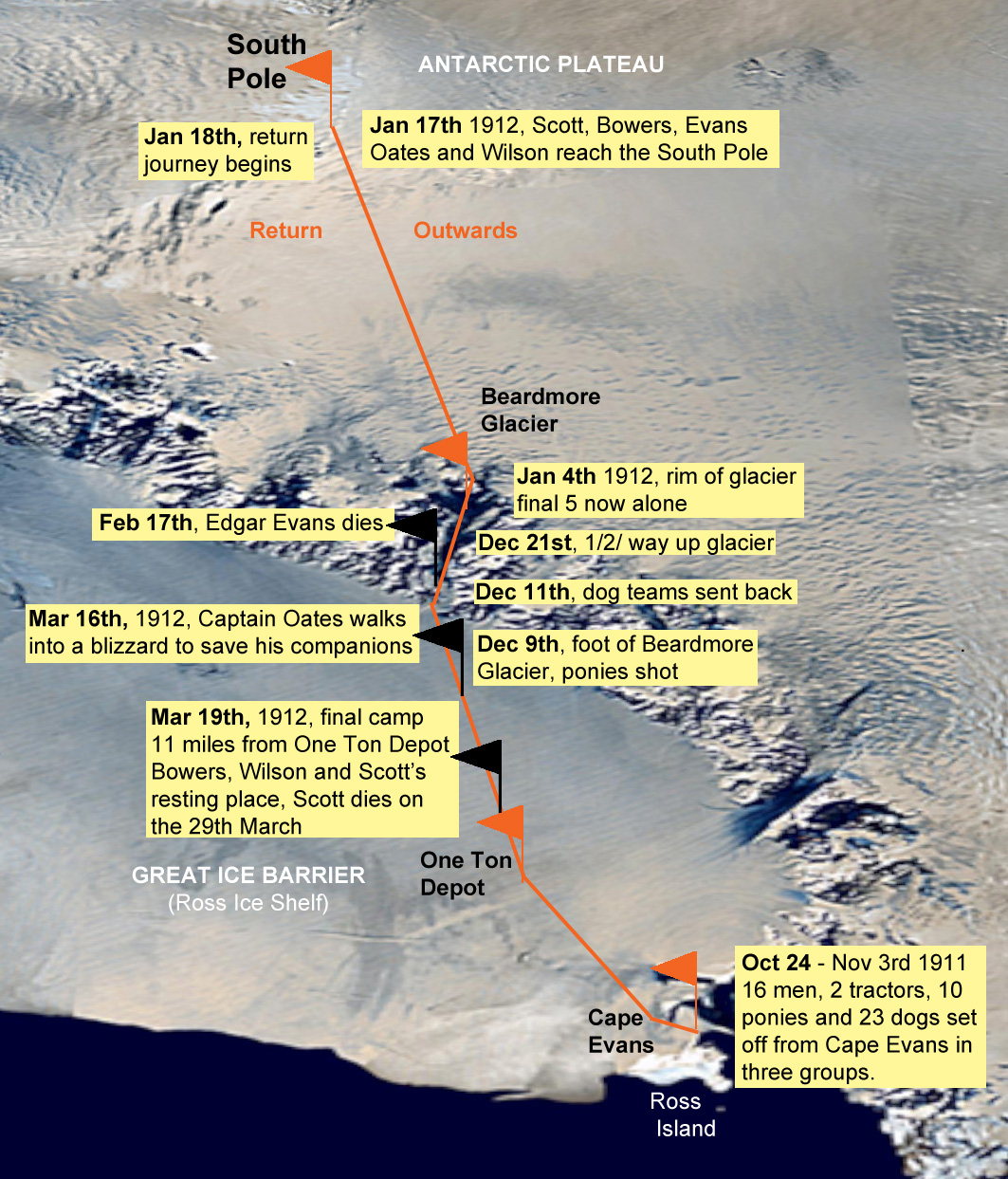
Contributory Factors to the Deaths of Scott and the South Pole Party
There was no particular one overriding factor that led to the mens' deaths, as they came so close to surviving. Lots of individual factors could have pushed them along for that final stretch and saved them. What is very difficult to quantify is how great an effect each had, though it is perhaps not fanciful to suggest that any one of them may have made the difference between life and death, if those last 11 miles could have been made before the blizzard sealed their fate, the polar party may have survived.
The experiences of Scott and his party delivered a great many lessons on survival in the Polar Regions, as did the comparisons with Amundsen and his team. While we can look back now and see what may seem obvious things, at the time they were far from obvious and only just being discovered, in part by men like Scott and his party, doing things the hard way.
Let us come back to Cape Evans
after the return of the First Supporting Party. Hitherto
our ways had always been happy: for the most part they had
been pleasant. Scott was going to reach the Pole, probably
without great difficulty, for when we left him on the edge
of the plateau he had only to average seven miles a day
to go there on full rations. We ourselves had averaged 14.2
geographical miles a day on our way home to One Ton Depot,
and there seemed no reason to suppose that the other two
parties would not do likewise, and the food was not only
sufficient but abundant if such marches were made.
Apsley Cherry-Garrard - The Worst Journey in the World
The Slow Effects of Insufficient Food
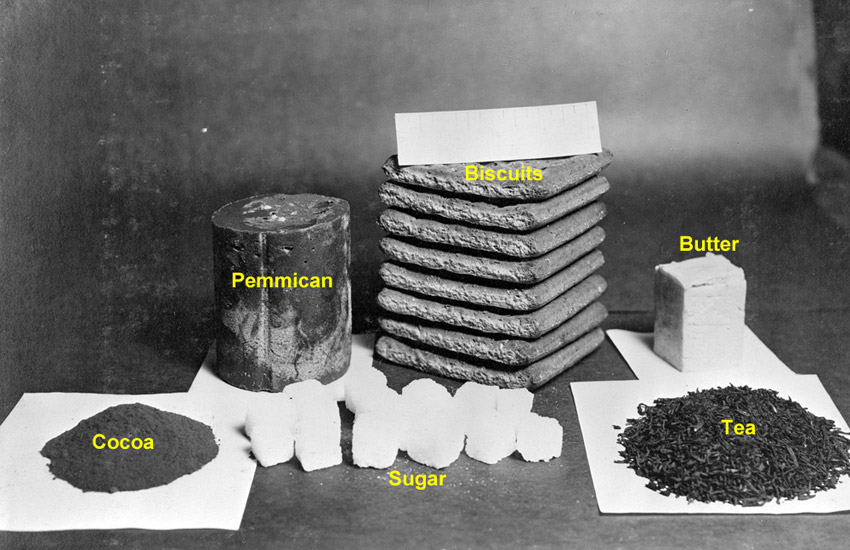 Rations
for one man for one day while manhauling
Rations
for one man for one day while manhauling
Scott and his men were supplied with rations of pemmican, sledging biscuits, sugar, butter, tea and cocoa powder that provided about 4,500 kilocalories per man per day on the way to the Pole and about 3,800 on the return journey, an average man not in the polar regions requires about 2,500 kilocalories per day. We now know that they were expending in the region of 7,000 kilocalories per day, greater than athletes in training, and for months on end. This amounted to a slow starvation diet where they were losing body mass, initially as fat and then later muscle. Fat is used by the body as an energy store and also as insulation against the cold. With reduced insulation in a very cold climate, the body would have to work even harder and burn more fuel in the form of food and then body fat and muscle to stay warm.
-
We are getting more hungry, there
is no doubt. The lunch meal is beginning to seem inadequate.
We are pretty thin, especially Evans, but none of us are
feeling worked out.
Scott's diary - January 28th 1912
Better rations would have meant better progress and less susceptibility to cold including frost bite and hypothermia.
As Scott and his party returned from the pole, they were managing to cover much less distance each day and were finding even this harder than it had been.
-
We did 4 1/2 miles this morning
and are now 8 1/2 miles from the depot - a ridiculously
small distance to feel in difficulties, yet on this surface
we know we cannot equal half our old marches, and that for
that effort we expend nearly double the energy.
Scott's diary - March 8th 1912
While Scott puts this down to the surface over which they are hauling the sledge, the distance they covered fell as time went on. The loss of muscle mass must have been making hauling the sledge more difficult along with less insulation from body fat meaning more of their food energy was going towards maintaining body temperature.
The rations carried were thought at the time to be the best balance of nutrients, they were 24% fat and 29% protein, similar rations today would have about twice the fat and a third of the protein. Fat has nearly twice the energy density (calories per gram) as protein, more fat would have meant about 20% more energy.
Scurvy
Scott's rations were low in vitamin C and those of the B group. The length of time the party were exclusively eating sledging rations was not enough to develop scurvy fully, though was long enough to start to develop some of the debilitating effects of running low on these vitamins, another negative effect to deal with.
Leaking Fuel Cans
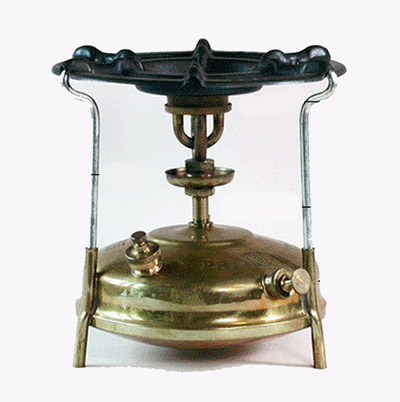 The
food carried on expeditions is low in water to save weight,
water is easily added at mealtimes by melting snow and ice,
though heating all that food, snow and ice from well below freezing
to boiling point for cooking and hot drinks takes a lot of fuel.
Fuel for cooking is therefore almost as important as food in
polar environments.
The
food carried on expeditions is low in water to save weight,
water is easily added at mealtimes by melting snow and ice,
though heating all that food, snow and ice from well below freezing
to boiling point for cooking and hot drinks takes a lot of fuel.
Fuel for cooking is therefore almost as important as food in
polar environments.
The standard expedition cooking equipment at the time of Scott's expedition (and still frequently used today) was the Primus stove, fuelled by kerosene (also called paraffin, Scott simply refers to it as oil) and pre-heated with methylated spirits. Primus stoves are efficient and more importantly than anything else, dependable, especially in extreme environments. There is an issue however in that the kerosene fuel is subject to an odd phenomenon called "creep", it slowly flows up and over containers. This happens to a greater degree in very cold environments to the point where kerosene can flow up the inside of a can and out through the tightly screwed on cap. If the can is heated by the sun during the day, this produces kerosene vapour at the top of the can which escapes more easily.
-
Found store in order except shortage
oil - shall have to be very saving with fuel
Scott's diary Feb 24th 1912
From this date onwards, Scott's party had less fuel at each depot than they had expected due to losses which limited the degree to which they were able to warm up with hot food and drinks and also raise the temperature in the tent. Some of the food will have had to be eaten cold, perhaps even part frozen. The lack of ability to melt snow and ice will also have led to dehydration which reduces physical efficiency.
Four, then five in the Polar Party
In all of his planning Scott had intended there to be four men in the final party that reached the pole. He set off on the 1st of November 1911 with sixteen men and various methods of transport, they laid depots of food and supplies to be used by those going to the pole during their return journey, and turned back in small groups as they got closer to the pole. Scott hadn't announced who his Polar Party would be until the last group were due to turn back. At the last minute, he decided that Henry "Birdie" Bowers should join the four. This meant that all the planned rations and fuel for four now needed to supply five (though they thought they had plenty). Edgar Evans died on the 17th of Feb 1912 which reduced the party to four again after 6 weeks of five men using rations for four.
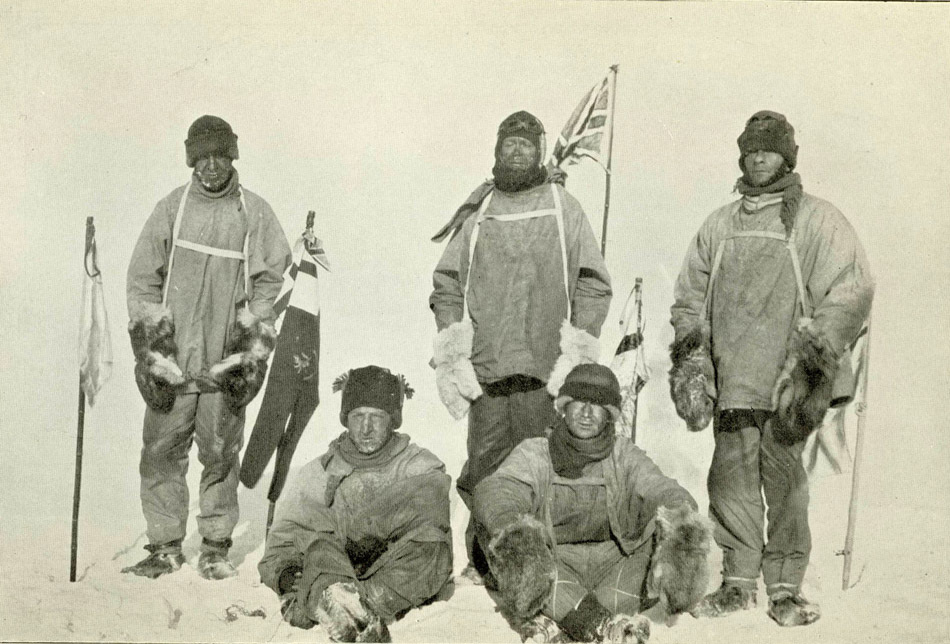
The South Pole
party from left to right
Oates, Bowers, Scott, Wilson, Evans.
They reached the Pole on the 18th of January 1912.
On the plus side, it meant an extra man to pull the sledge, though Bowers didn't have skis, the other four had them as planned but he had to trudge through deep soft snow by walking.
The Role of Amundsen
During all his planning of the British Antarctic Expedition on the Terra Nova, Scott had intended that the main objective was "to reach the South Pole, and to secure for the British Empire the honour of this achievement". He announced this publically well in advance in 1909 and was not made aware that any other expedition would be in Antarctica at the time making an attempt on the Pole. He was not told of Amundsen's attempt until he received a telegram from Amundsen in September 1910 when the Terra Nova was in Melbourne, Australia.
BEG LEAVE TO INFORM YOU. FRAM
PROCEEDING ANTARCTIC.
Telegram from Amundsen to Scott,
September 9th 1910
Amundsen later claimed he thought Scott's expedition was scientific only with the Pole being a side issue, despite Scott's clear earlier announcement.
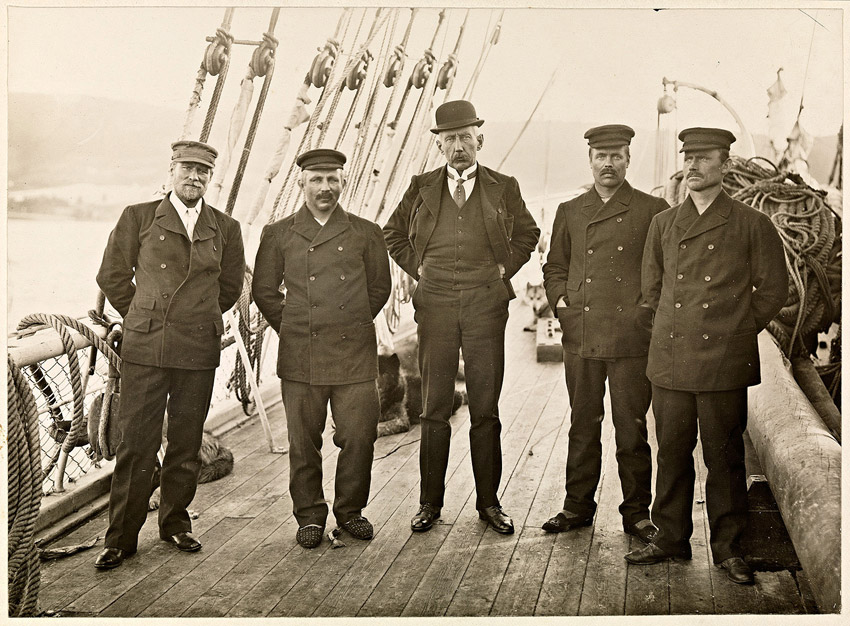
Amundsen and
his South Pole party aboard
the Fram on arrival at Hobart
Scott's plans were to set off on November the 1st 1911 when the weather was suitable for the Siberian ponies he had taken this was later than if only dog teams were used as dogs are more resilient to the cold. Amundsen effectively contrived a race with Scott and surprised Scott with the news knowing that his dogs probably gave him an advantage though was concerned Scott might beat him to the pole with his motor sledges. Scott at no point sought or entered into a race and decided not to let Amundsen force him into changing his plans.
Amundsen had originally planned an expedition to be the first to reach the North Pole, a plan that was in ruins when Cook and Peary claimed to have already reached it separately in 1908 and 1909 respectively. Facing financial ruin if he couldn't produce something to satisfy his backers and generate money from a success, he decided to go to the South Pole. When his ship, the Fram left Norway, only 3 other men including the captain were told of the real destination, Amundsen thought his backers might object if they knew in advance, the rest of the crew were told when they reached Madeira under the guise of being there on an oceanographic cruise. He was between a financial rock and a hard place largely of his own making and needed a way out, a Race to the Pole was the answer.
This aspect is sometimes portrayed as the manners of a by-gone age, a defunct code of honour amongst gentlemen, outdated arcane rules broken by Amundsen who became the winner in his own race. The interpretation of this is very subjective, personally I feel that Amundsen did behave badly and hoped that he would get away with it. Knowing he would not get permission, he hoped for forgiveness instead, and all the easier to forgive the transgression of etiquette of someone who had achieved a heroic "First". Had Scott and his men returned alive, Amundsen's act would probably have largely been forgiven and things would mostly have been well, however they didn't. I also think that if someone behaved the way Amundsen did today, it would still be seen as very dishonourable and unsporting behaviour, not just "of its time".
The impact of Amundsen comes in the form of the blow to the morale of Scott's party on finding out that they were beaten to the South Pole after all their planning and efforts.
The mood of Scott's diary changes like a switch being flipped after the 15th of January 1912:
It is wonderful to think that
two long marches would land us at the Pole. We left our
depot to-day with nine days' provisions, so that it
ought to be a certain thing now, and the only appalling
possibility the sight of the Norwegian flag forestalling
ours. Little Bowers continues his indefatigable efforts
to get good sights, and it is wonderful how he works them
up in his sleeping-bag in our congested tent. (Minimum for
night -27.5°.) Only 27 miles from the Pole. We ought to
do it now.
Scott's diary - Jan 15th 1912
The worst has happened, or
nearly the worst........ The Norwegians have forestalled
us and are first at the Pole. It is a terrible disappointment,
and I am very sorry for my loyal companions. Many thoughts
come and much discussion have we had. To-morrow we must
march on to the Pole and then hasten home with all the speed
we can compass. All the day dreams must go; it will be a
wearisome return.
Scott's diary - Jan 16th 1912
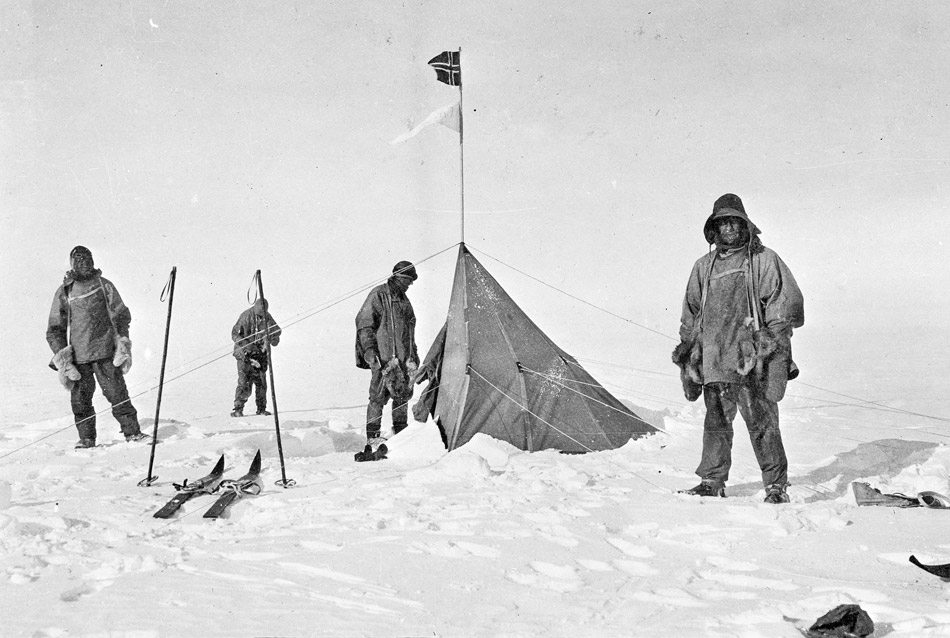 Scott's Polar party
at Amundsen's tent and marker flag, January 18th 1912, about
a month after Amundsen's party had reached the Pole on the
14th of December 1911.
Scott's Polar party
at Amundsen's tent and marker flag, January 18th 1912, about
a month after Amundsen's party had reached the Pole on the
14th of December 1911.
From this entry onwards there is virtually no optimism, none of the former joy or enthusiasm for the task in hand, just an increasingly desperate tale of a slow walk and battle for survival that ends in tragedy.
Amundsen didn't physically make anything difficult for Scott, he didn't interfere in his journey, send him the wrong way, slow him down or do anything else that directly made his journey more arduous.
If Amundsen hadn't got to the pole first though, and if Scott and his party had been buoyed up with an eagerness to get home to tell the world of their success, would the cumulative effect over the ten weeks since the pole have been enough to push them over that final 11 miles between life and death?
Amundsen took the criticism of the manner in which he "won the race" to reach the Pole first badly. He is said to have been much troubled by Scott and his men dying and was described as being unhappy after the south polar expedition and that his life after that was an anti-climax. He had won, but it was not a clean win and he knew it.
Misunderstood orders?
About the first week of February
I should like you to start your third journey to the South,
the object being to hasten the return of the third Southern
unit.. aim at meeting the returning party about March 1
in Latitude 82 or 82.30
Scott's orders left at
Cape Evans, 20 Oct 1911
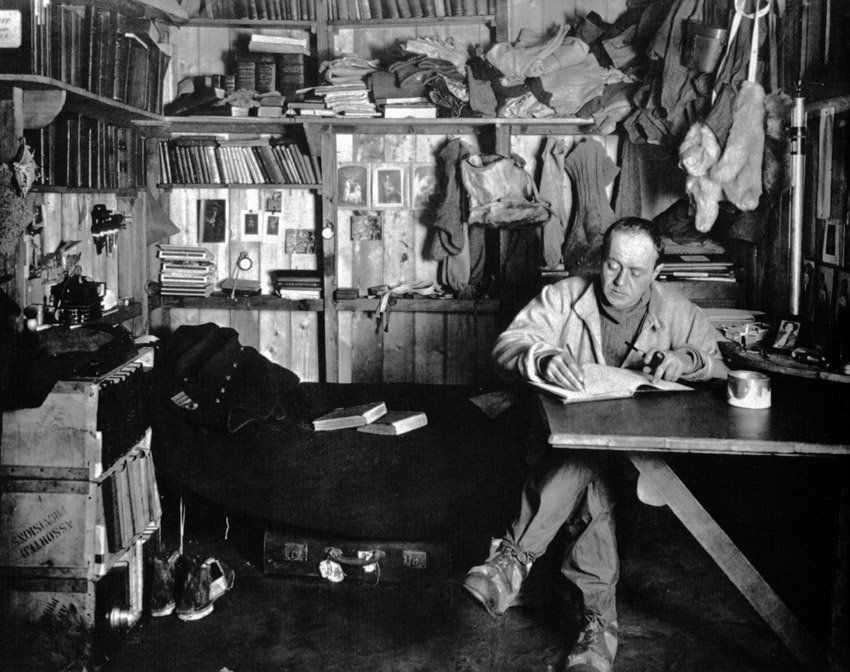
Scott writing
at his desk in the expedition hut
One Ton Depot, that Cherry-Garrard and Dimitri Girev (usually referred to as Dimitri) reached on the 4th of March was at 79° 29' S, this was about 35-70 miles north of where Scott said he wished to be met. Cherry-Garrard thought he was too early, he thought if they continued further south, there was a good chance that because the weather was windy with poor visibility, they may simply not see Scott and the Polar Party and he had orders not to risk the dogs by proceeding further south, a lack of dog food would have meant killing some dogs as food for the others. On March the 1st Scott was at about latitude 81.30, a little further on than he thought he would be and starting to get into serious difficulties.
Cherry-Garrard remained at One Ton Depot until the 10th of March when he had no further rations to stay any longer and returned to the expedition base. He thought the Polar Party had plenty of food and fuel and didn't imagine them to be in difficulties. He had received his orders from Edward Atkinson, the expedition surgeon who was in command at the base. Atkinson had used the men on base to unload the Terra Nova recently arrived with fresh supplies rather than getting the ships company to do the job at the time when those on base should have been setting out to meet Scott. He sent out Cherry-Garrard as he was less important to the scientific element of the expedition than was senior physicist Charles Wright, a much more skilled navigator who could have ventured further south with confidence.
Cherry-Garrard, just 24 at the time, held himself responsible for the rest of his life for not going further south when Scott was so close. It contributed to a mental breakdown and he suffered from what we now know as post-traumatic stress disorder (PTSD) for the rest of his life.
Transportation Choices
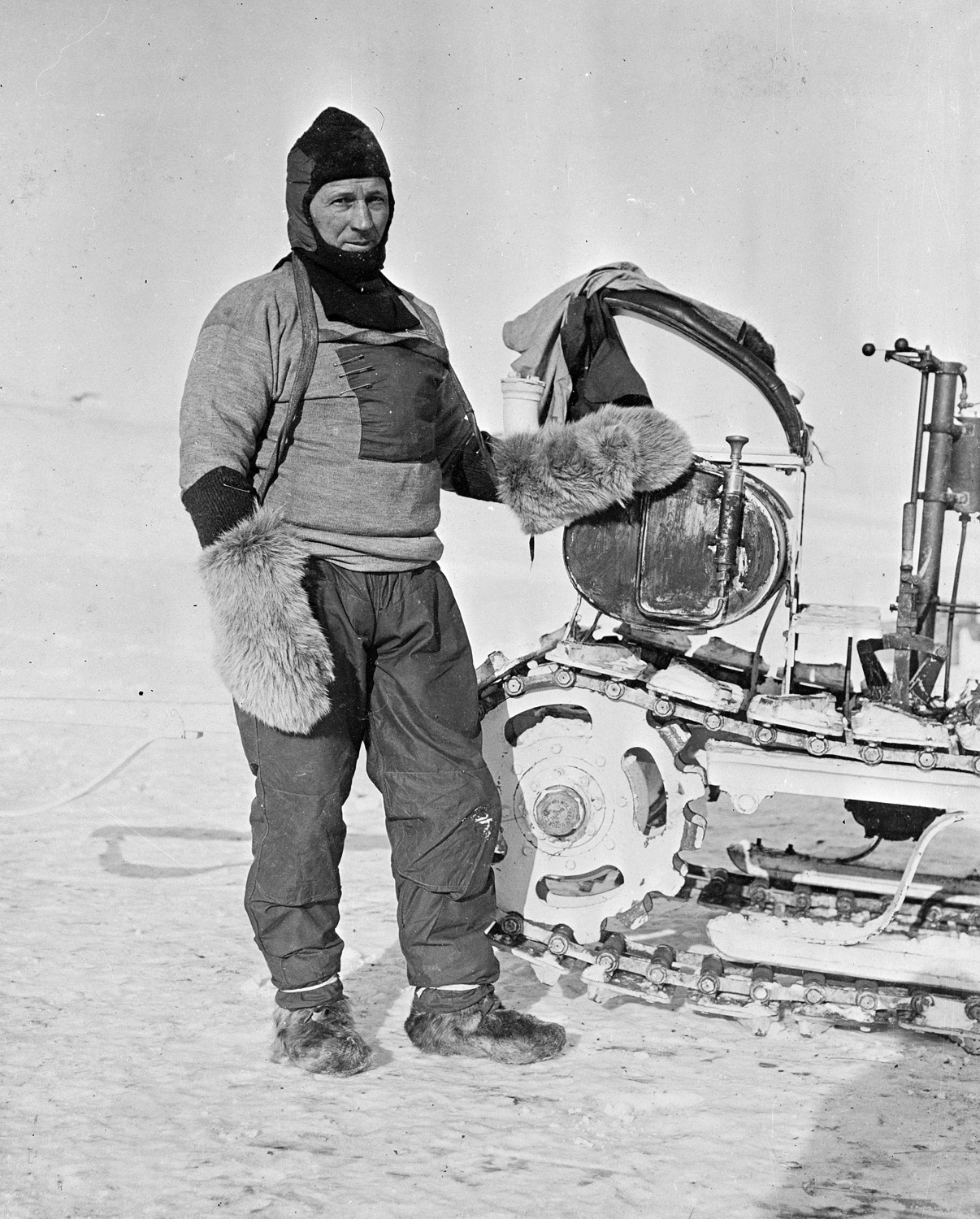 William Lashley with one of the motor
sleds
William Lashley with one of the motor
sleds
Much has been written about Scott's choice of transportation for his South Pole attempt. He took motor sledges a new technology at an early point in development and almost untried in Antarctica, though some lessons had been learned from Shackleton taking the first car to Antarctica on his 1907-09 expedition. There was no reason not to try this technology as no-one knew how it would cope without experimentation and his sledges were tracked whereas Shackleton's car had wheels.
Other than man-hauling, Scott's main means of transportation was Siberian Ponies. These were small cold-hardy animals, though not really suited for Antarctica. He also took dog teams, though didn't train his men sufficiently in their use and didn't use them as much as he could. Man-hauling was seen as a more noble means of transport with a long naval tradition in the Polar Regions (Scott was very much a Navy man). While motor sledges, ponies and dog teams were used to help pull supplies and lay depots, the last stretch to the Pole and most of the return journey was always going to be manhauled.
Discomfort aside, the biggest problem with using manhauling was that the amount of energy and therefore food needed to do so to the pole and back was significantly underestimated leading to the slow and inevitable starvation mentioned above.
While Scott has had his transport choices and the way he deployed them dissected endlessly, somewhat ironically modern explorers and adventurers have gone back to the more "pure" method of manhauling with some even considering that using sails or kites is an unacceptable level of "support".
Weather on the Return Journey
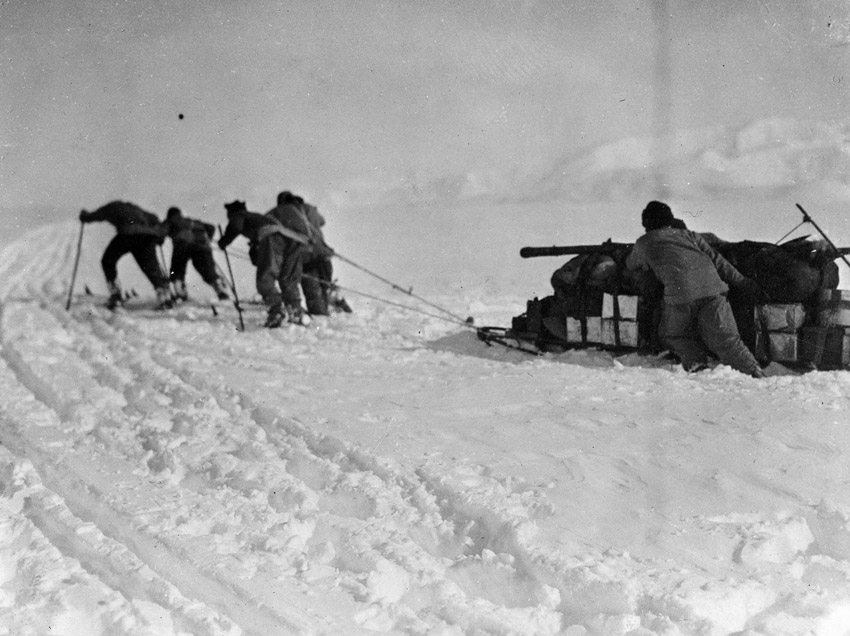
Heavy hauling
in difficult surface conditions
There is now much evidence to suggest that the weather that Scott encountered on his return journey from the Pole was unusual. The daily minima from late February until the final camp were an additional -10 to -20F below what would normally be expected in that area at that time of year. The particularly cold conditions that Scott experienced in 1912 can be expected about once every 15 years. These unusually low temperatures had several effects:
- It made the ice surface over which the sledge was pulled
less slippery and more difficult to haul over. A loaded
sledge can be pulled over a hard flat surface with surprisingly
little extra effort above walking. If the surface is of
the fine crystalline "sandy" texture that Scott
frequently reports, it becomes more difficult.
- Food and snow for cooking and drinking was colder and
so needed more fuel to warm it up, fuel that was already
running out in the latter stages as canisters in depots
had leaked. It is likely that some of the food they ate
would not have been fully warmed up, so using their reserves
of body heat.
- It placed greater stress on the physiology of the men
as they tried to stay warm in the extreme cold so contributing
substantially to exhaustion.
- It made frostbite far more likely, Oates in particular
suffered from frostbitten feet and later hands, Scott had
a frostbitten foot that would have kept him in the tent
in the final camp even if Bowers and Wilson had been able
to continue to One Ton depot.
- Setting up camp, breaking camp in the morning, putting on clothes and especially boots that were stiff with frost and icily cold all take longer the colder it is and are taxing on morale.
The unusual weather also had other effects in that it
brought blizzards such as the one that pinned Scott down in
the tent for 4 days on the way to the pole, consuming rations
and fuel and making no progress. It likely had an effect on
the wind direction, whereas Scott could have expected a tail
wind to help him on his way home, it was mostly absent or there
was a head wind instead.
Without the exceptional weather encountered by Scott late in the season, his party may well have survived. Amundsen in setting out and returning earlier avoided the worst effects of these weather conditions.
Conclusion and Further Thoughts
Because Scott came so close to returning successfully with at least most of his party alive, the failure to do so can be potentially attributed to almost anything or everything he did or didn't do that was less than perfect.
Unfortunately some have taken Scott's failure to indicate that he was clueless from start to finish and he is sometimes spoken or written about in quite undeserved derogatory terms, especially by armchair explorers inexperienced in the polar regions. Conversely Amundsen with his success is sometimes spoken of as if he was a master strategist who could do no wrong.
On the 8th of September 1911, Amundsen made a too early start on the Pole against the advice of Hjalmar Johansen, one of his most experienced men. This resulted in a shambolic failure with the party returning piecemeal in disarray with many frostbites and accusations of some of the men being abandoned without food or fuel and left to their own devices straggling back to Framheim many hours later than the more experienced men. This failure about 6 weeks before the successful attempt is rarely mentioned. The men were so cold at night that they barely slept, some dogs paws became frostbitten and by the day of return some of the dogs had frozen to death or were so weak they had to be carried on the sledges. The reason for setting off so early was to be sure to beat Scott who wasn't racing, though Amundsen had staked his financial solvency on reaching the South Pole first. He was lucky he got away with it.
The successful are often keen to dismiss any aspect of good luck in their success and equally keen to point out the failings of others such as their lack of planning and preparation as being the most important factor in their lack of success rather than any aspect of bad luck.
I may say that this is the
greatest factor - the way in which the expedition is equipped
- the way in which every difficulty is foreseen, and precautions
taken for meeting or avoiding it. Victory awaits him who
has everything in order - luck, people call it. Defeat is
certain for him who has neglected to take the necessary
precautions in time; this is called bad luck.
Roald
Amundsen.
The reality is somewhere in-between. Of course planning and preparation are vital for success, but sometimes the unforeseen thwarts the objective, at other times the unforeseen makes life easier and delivers an easier or exaggerated success. At some point we must stop the planning and actually go out and do things, sometimes we may find ourselves in the 5th or the 95th percentile of the range of conditions we expected and cruise home easily or fail gracelessly.
Scott would almost undoubtedly have returned safely with most or all of his men with some better planning and/or some better luck. The irony is that Scott's failure, the success of reaching the pole being taken from him, also became Amundsen's failure. Amundsen's rather sneaky tactics to save his fortunes depended on beating Scott, though in beating him in the way he did, he sealed his own fate, celebrations of his success sometimes came rather grudgingly.
I almost wish that in our
tribute of admiration, we could include those wonderful,
good-tempered fascinating dogs, the true friends of man
without whom Capt. Amundsen would never have got to the
Pole. I therefore propose three cheers for the dogs.
Lord Curzon - Britain's Royal Geographic Society
dinner in London to celebrate Amundsen's achievement
Scott helped Amundsen in that he confimed that he had indeed reached the South Pole. Without Scott, there would have been no independent confirmation that Amundsen had been there, possibly in the manner of the uncertainty of Cook and Peary each claiming to have reached the North Pole in 1908-1909 (though as it transpired in all likelihood, neither of them actually reached the North Pole).
Scott and Amundsen both independently reaching and determining the same spot to be the South Pole, along with Scott taking photographs and bringing back the letters Amundsen had left confirmed that both men had been there.
Robert Falcon Scott Books and Video

The Coldest March: Scott's Fatal Antarctic Expedition
by Susan Solomon
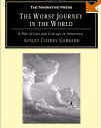
The Worst Journey in the World. Apsley Cherry-Garrard

The Voyage of the Discovery: Scott's First Antarctic Expedition
by Robert Falcon Scott, Ross MacPhee (Introduction), Fridtjof Nansen (Preface)

The Great White South: Travelling with Robert F. Scott's Doomed
South Pole Expedition by Herbert Ponting

Scott's Last Expedition: The Journals of Captain R.F.Scott

Edward Wilson's Antarctic Notebooks
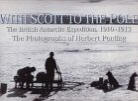
With Scott to the Pole
Herbert Ponting, illustrated

Discovery Illustrated: Pictures from Captain Scott's First Antarctic Expedition

Captain Scott by Sir Ranulph Fiennes

90 Degrees South: With Scott to the Antarctic (1933) DVD

History Chapters: Roald Amundsen and Robert Scott Race to the South Pole. Ages 4-8

Diary of the "Terra Nova" Expedition to the Antarctic, 1910-12
